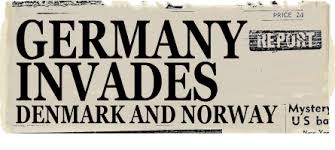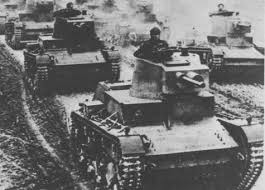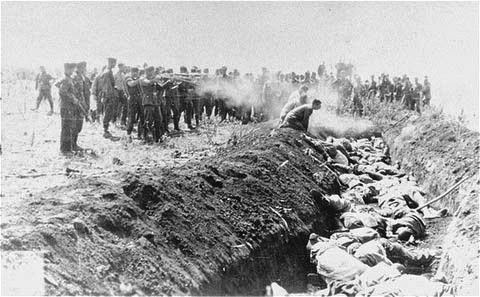Hero or villain? Arthur Nebe was commander of Einsatzgruppen B and responsible for mass executions during the Holocaust. He was also a member of the resistance and was executed by the Nazis for his involvement in the July 20 Plot.
K.P. Emmert is a historical fiction author. Her first novel Slow Boil is set in Nazi Germany.
Tuesday, May 13, 2014
Monday, May 12, 2014
Behind the Page... Stauffenberg
Claus Graf von Stauffenberg is probably the most well known of all of the July 20 conspirators since he was the one that set the bomb in the bunker that was supposed to kill Hitler. The bomb did detonate, but Hitler survived. Stauffenberg was executed by firing squad on July 20, 1944. The movie Valkyrie (Tom Cruise stars as Stauffenberg) is quite good and pretty much historically accurate.
Friday, May 9, 2014
Behind the Page... Olbricht
Friedrich Olbricht was a key member of the resistance because of his position in the Army High Command in Berlin. After the failed assassination attempt of July 20, 1944, he was executed.
Thursday, May 8, 2014
Behind the Page... Schlabrendorff
Fabian von Schlabrendorff served as Tresckow's adjutant on the eastern front in Army Group Center. He acted as a liaison between Tresckow and Oster to coordinate the resistance. Schlabrendorff's memoirs We Almost Killed Hitler provided the inspiration for Kurt's activities in the resistance during the last part of Slow Boil. Amazingly, Schlabrendorff survived imprisonment and torture.
Wednesday, May 7, 2014
Behind the Page... Gersdorff
Rudolf von Gersdorff attempted to assassinate Hitler by wearing a bomb during a museum tour with Hitler. The attempt failed, but Gersdorff was not discovered. Gersdorff survived the war and recorded his involvement in the resistance movement in his autobiography Soldier in the Downfall.
Tuesday, May 6, 2014
Behind the Page... Tresckow
Henning von Tresckow was the driving force behind the resistance to Hitler in the Wehrmacht. As Chief of Staff of Army Group Center on the eastern front, he, like Oster, surrounded himself with like-minded people. He played an instrumental role in several attempts on Hitler's life. When the July 20 Plot failed, he committed suicide rather than risk exposing others to Nazi reprisals.
Monday, May 5, 2014
Behind the Page... Beck
General Ludwig Beck was Chief of the General Staff for the Wehrmacht. He resigned in protest to Hitler's military policies despite Oster's advice to the contrary. He later became the ruling patriarch of the July 20 Conspirators. He was allowed to shoot himself rather than face death by firing squad on July 20, 1944.
Saturday, May 3, 2014
Behind the Page... Goerdeler
Carl Goerdeler was one of the most prominent civilians involved in resistance to the Nazi regime. He served as the mayor of Leipzig until removed from office for his outspoken anti-Nazi positions. While Goerdeler did break under Nazi interrogation, his long fight against Nazism should be how he is remembered. He was murdered by the Nazis.
Thursday, May 1, 2014
Behind the Page... Oster
General Hans Oster is my personal favorite among the July 20 Conspirators. Early on he saw the evil for what it was and fought it. As deputy of the Abwehr, the military intelligence branch of the Wehrmacht, he used his position to influence and attempt real change even plotting a coup as early as 1938. He filled the Abwehr with like-minded individuals such as Dohnanyi and Bonhoeffer. Oster was also murdered by the Nazis.
Wednesday, April 30, 2014
Behind the Page... Canaris
Admiral Wilhelm Canaris was Chief of the Abwehr, the military intelligence branch of the Wehrmacht, in Nazi Germany. Early on he disliked Hitler and Nazi policies but felt himself too old to effectively coordinate a coup. Instead, he empowered his deputy General Hans Oster to do just that. Canaris was murdered at Flossenburg concentration camp in April 1945.
Monday, April 28, 2014
Behind the Page... Gas Vans
Himmler became concerned about the brutalizing effect that shooting Jews and other victims of Nazi ideology had on the Einsatzgruppen soldiers. He ordered that a more efficient and distant form of killing be developed. The first attempt at this were the gas vans. The exhaust pipes were inserted into the back of the sealed van so that victims died of carbon monoxide poisoning.
Sunday, April 27, 2014
Behind the Page... Babi Yar
Not everyone died immediately. Often Einsatzgruppen soldiers would go into the pit and shoot survivors. This is the sort of scene that Kurt witnessed at Babi Yar.
Saturday, April 26, 2014
Behind the Page... More Einsatzgruppen
The Einsatzgruppen quickly became more organized in their approach to mass execution. Jews in Ukraine and Russia were shot on the edge of a pit so that their bodies would fall into the pit making burial more convenient.
Friday, April 25, 2014
Behind the Page... Einsatzgruppen
The special killing squad units of the SS who were the first perpetrators of the "Final Solution" on a large scale were called Einsatzgruppen.
Wednesday, April 23, 2014
Tuesday, April 22, 2014
Monday, April 21, 2014
Behind the Page... Civilians suffer
The
failure of German supply lines during Operation Barbarossa meant that
the Ukrainian and Soviet civilians suffered greatly as the German Army
plundered the countryside.
Sunday, April 20, 2014
Saturday, April 19, 2014
Behind the Page... Soviet POWs
Operation
Barbarossa was so successful at first that the German Army didn't quite
know what to do with all of the Soviet POWs. Hitler and Himmler did.
Most Soviet POWs died in concentration camps.
Friday, April 18, 2014
Thursday, April 17, 2014
Wednesday, April 16, 2014
Behind the Page... Hitler betrays Stalin
Hitler
and Stalin signed the Non Aggression Pact in August 1939. When Germany
invaded the Soviet Union in June 1941 during Operation Barbarossa, the
treaty ended.
Sunday, March 16, 2014
Struggling
I've written about half of the sequel to Slow Boil (which still doesn't have a title) and find that I need to pause and do some more research. I don't mind the research; in fact I love the research. I'm struggling to find the time that I want to devote to it. So much other "life" is consuming my time. I'm hoping that after Spring Break I'll have more time to just read and research.
Saturday, March 15, 2014
Thursday, March 13, 2014
Behind the Page... Battle of Britain
London was devastated by the bombings. Children were sent to live in the countryside in order to keep them safe. The Battle of Britain is why the Pevensies in The Lion, the Witch and the Wardrobe go to live with Professor Kirke.
Tuesday, March 11, 2014
Monday, February 10, 2014
Gurs Concentration Camp
The German Jews of Baden were sent to a concentration camp in Gurs, France. This was not a "death" camp; there were no gas chambers. However, it was a prison camp, and the conditions were miserable.

Saturday, February 8, 2014
The first deportation
German Jews in Baden hold the dubious distinction of being the first German Jews deported by the Nazis, and the only German Jews to be sent west. Heidelberg, the main setting of Slow Boil, is located in Baden. Thus, the depiction in Slow Boil of German Jews being deported west in 1940 is accurate despite the unusual aspects of the scenario.

Thursday, February 6, 2014
The Phony War
While Great Britain and France did finally declare war on Germany in September 1939 after the invasion of Poland, they didn't do anything. In the meantime, Hitler and Stalin invaded Scandinavian countries. So great was the inactivity of the Allies that the period from September 1939 to June 1940 has been dubbed The Phony War.

Tuesday, February 4, 2014
Book Recommendation... The Endless Steppe
The Endless Steppe is an autobiography by Esther Hautzig about her experience growing up in exile on the Russian Steppes. She and her family were Polish Jews deported and exiled by the Soviet Union after the Soviets invaded "their half" of Poland. Great book to read to your school age kids!

Sunday, February 2, 2014
A little helping hand from Stalin
Despite being sworn enemies, Stalin and Hitler could agree on one thing. They both wanted Poland. That was the essence of the Non-Agression Pact. The Soviet Union would invade the eastern half of Poland and Germany the western. This is the truth behind why Poland was conquered so quickly; they were invaded on both fronts.

Friday, January 31, 2014
Your history textbook was wrong
When Germany invaded Poland, some American journalist dubbed the campaign blitzkrieg which means lightening warfare. Not true. There was an actual Blitzkrieg strategy developed by the German military, but it called for unconventional punching holes in lines and other military stuff that I really don't understand. The German invasion of Poland was fast, conventional warfare but not actually blitzkrieg.

Friday, January 10, 2014
Behind the Page... the Terror of Kristallnacht
Kristallnacht was the first time that most German and Austrian Jews
felt real terror in the face of Nazi persecution. While many of their
Gentile neighbors helped, more did not. For every story of a kind
Gentile helping a Jew in his time of distress, there are probably five
stories of former Gentile "friends" shunning or profiting. Kristallnacht
changed everything.
Wednesday, January 8, 2014
Behind the Page... Insult to Injury
As if
the looting and plundering of Jewish owned businesses, the burning of
synagogues and arrest of tens of thousands of men were not bad enough,
the Nazis decided to make "the Jews" pay for the Nazi riots. This was,
of course, no more than a power grab. The Nazis used the chaos left in
the wake of Kristallnacht as an opportunity to seize control of Jewish
owned businesses and assets.
Monday, January 6, 2014
Behind the Page... International Reaction to Kristallnacht
As seen in this newspaper headline from the time, the international
community was very aware of the persecution of Jews in Germany, Austria
and Czechoslovakia. Great Britain responded
by allowing 10,000 Jewish children from Germany, Austria and
Czechoslovakia to immigrate to the UK (known as the Kindertransports).
The USA decided it would be wrong to separate Jewish children from their
families and refused to welcome these children. A shameful moment in
American History.
Saturday, January 4, 2014
Thursday, January 2, 2014
Behind the Page... More on Kristallnacht
Thousands of synagogues were burned during Kristallnacht. As portrayed
in Slow Boil, fire fighters were on hand only to ensure that the fire
did not spread to "Aryan" property.


Subscribe to:
Comments (Atom)




























